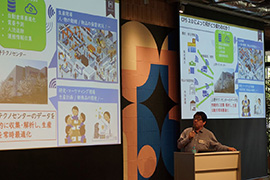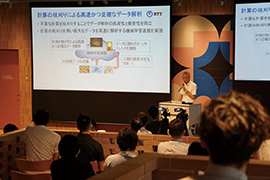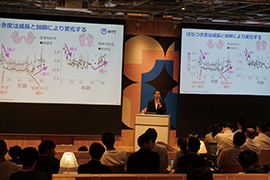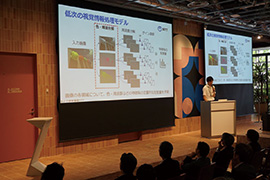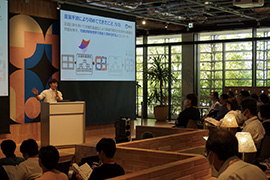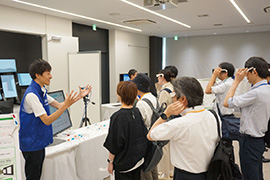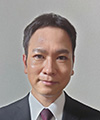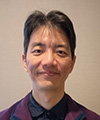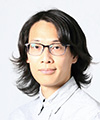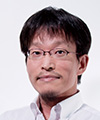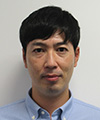 |
|||||
|
|
|||||
|
Information Vol. 23, No. 2, pp. 35–40, Feb. 2025. https://doi.org/10.53829/ntr202502in1 Event Report: NTT Communication Science Laboratories Open House 2024AbstractNTT Communication Science Laboratories hosted the Open House 2024 from June 24 to 26, 2024, as an event showcasing its recent research achievements. While the COVID-19 pandemic restricted the scale of Open House events until 2023, the Open House 2024 had a larger capacity than the previous year with its venue floor space practically doubled and its period extended from two to three days. This article reports on the holding of the Open House 2024. Keywords: information science, human science, AI 1. Overview of Open HouseSince the founding of NTT Communication Science Laboratories (CS Labs), we have been engaged in cutting-edge basic research to achieve heart-touching communication between humans and between humans and computers. As an event to “see, touch, and feel” our latest achievements, the Open House has regularly been held from late May to early June at the NTT Keihanna Building (Seika-cho, Kyoto Prefecture). However, the on-site Open House was canceled for three years from 2020 to 2022 due to the COVID-19 pandemic, so we held it online and presented videos of talks and research exhibits on the Open House website. In 2023, though, it was felt that the COVID-19 pandemic was coming to an end due to the virus’s reclassification as a Class 5 infectious disease in Japan. Taking the safety and comfort of all participants into account, we thus introduced a pre-registration system and held the Open House on-site for the first time in four years while reducing the scale of the event compared with past years. We chose QUINTBRIDGE (Osaka City, Osaka Prefecture), an open-innovation facility of NTT WEST with convenient access from major train stations in the Kansai region, as the venue. In 2024, considering the importance of convenient venue access, we continued with QUINTBRIDGE as the venue, but we expected even more visitors this time around. We thus used PRISM, an NTT WEST facility adjacent to QUINTBRIDGE, as an additional venue. This practically doubled the venue area, and in addition to extending the event period from the traditional two days to three days, we presented an invited talk and research talks on-site at the venue for the first time in five years since the 2019 Open House (recorded videos of talks were presented online from 2020 to 2023). Given conditions under which the COVID-19 pandemic had largely subsided, we maintained the pre-registration system and had 895 visitors, more than double the number from 2023, from a variety of companies, research institutions, and universities, in addition to NTT Group employees. 2. Invited talkFor the invited talk, Katsuki Fujisawa, Professor, Department of Mathematical and Computing Science, School of Computing, Tokyo Institute of Technology, presented his contribution titled “Creating the Next Generation Factory Together” (Photo 1). Artificial intelligence (AI) has made remarkable progress. AI that can give answers in a conversational manner to questions input by text on a smartphone has become a familiar presence in our lives. It is thought that AI, instead of being locked into a digital existence with smartphones and other devices, will broaden its application to spaces in which people and things actually exist. With an eye to achieving such a society, Professor Fujisawa has been researching a cyber-physical system (CPS) that seamlessly connects virtual cyber space where AI exists and the real world (physical space) where people and things exist with a focus on factories. While the introduction of AI is no longer rare in factories operated by large companies, the part optimized by AI and the part executed on the basis of human knowledge and experience exist independently, so the problem arises in that the entire operation is not necessarily optimal. Data analysis and simulations using digital twins are progressing, but feedback to the real world has stopped at visualization. As a proposal for improving this situation, Professor Fujisawa introduced the idea of extending measurements beyond the entire factory to peripheral areas related to the factory such as sales offices, external warehouses, and marketing sites, making optical calculations within a realistic period in cyber space, and reflecting those results in the real world. To this end, he emphasized the importance of mathematical optimization for instantly outputting results from a large volume of data, communications technology for connecting remote locations with low latency, and CPS modeling through the collaboration of factory operators and AI engineers. The content of this talk is deeply related to further progress in Digital Twin Computing and the All-Photonics Network in the Innovative Optical and Wireless Network (IOWN) promoted by the NTT Group. The invited talk by Professor Fujisawa and the research talks listed below will be available on the Open House website (in Japanese only) [1] for approximately one year.
3. Research talksThe following four research talks were given on themes with an especially high profile from among the notable research results from CS Labs. These talks, including the invited talk described above, were held on the Main Stage on the first floor of QUINTBRIDGE. A question and answer (Q&A) session with visitors followed each of these talks for the first time in five years. In a talk titled “Fast knowledge discovery from big data—Large-scale data analysis with accuracy guarantee via efficient pruning methods—,” Dr. Yasuhiro Fujiwara (Media Information Laboratory) introduced technology for achieving both accurate and fast data analysis as a means of reducing computational cost in large-scale data analysis (Photo 2). Approximate calculations are generally used to reduce computational cost, but the results obtained at high speeds by such calculations deviate from exact results. This talk introduced, in particular, three approaches to reduce computational complexity while maintaining accuracy: omission of computations using upper and lower bounds, termination of computations that cannot yield solutions, and fast computations through optimistic processing.
Dr. Atsushi Takagi (Human and Information Science Laboratory) gave a talk titled “The crux of human movement variability—Mistimed motor signals from the brain affect the precision of movements—.” He introduced research showing that “volatility in the timing control in the brain to move muscles” is the cause of variability in human movement (Photo 3). Using a method developed in this research for measuring movement ability by observing timing volatility during movement, he showed that the dominant hand exhibits less variability in repeated movement than the non-dominant hand and that movement variability decreases with growth in the young while increasing in the elderly. He also introduced an app developed on the basis of this research for easily evaluating the dominant hand and dominant foot. Visitors could try this app at a related exhibit.
In his talk titled “Human-centric image rendering for natural and comfortable viewing—Image optimization based on human visual information processing models—,” Dr. Taiki Fukiage (Human and Information Science Laboratory) introduced research on modeling visual information processing within the human brain and optimizing displayed images based on that model (Photo 4). Advances in information-display technology and display devices are opening up the possibility of using just about any place in real space as a screen for displaying information in the near future. However, with new display technologies that use projectors or see-through displays, the appearance of the displayed image can vary greatly depending on ambient light, background patterns, and other factors. Thus, an ideal display, as in a movie theater, cannot always be achieved. In response to this problem, Dr. Fukiage introduced an approach to understanding how humans see things and to achieving a realistic, more natural, and effective display method.
Dr. Kengo Nakamura (Innovative Communication Laboratory) gave a talk titled “Towards reliable infrastructures with compressed computation—Efficient algorithms for network analysis problems with decision diagrams—.” He proposed algorithms using decision diagrams, a technique for compressing and representing a massive number of combinations, and introduced examples of solving difficult analysis problems in a realistic period (Photo 5). Modern society depends on many network infrastructures such as telecommunication and road networks, and analyzing their performance is essential. However, such performance analysis has often had to handle the combinations of nodes and links that make up the network. This process significantly increases computation time, preventing sufficient analysis from being executed in a realistic time frame. In his presentation he showed one example of conducting analysis using a decision diagram to compress and represent a massive number of combinations, i.e., computations could be executed 30 million times faster, and in another example, 10 septillion (1025) times faster.
4. Research exhibitsThe Open House 2024 featured 22 exhibits showcasing recent results from CS Labs in the four categories of Science of Machine Learning, Science of Communication and Computation, Science of Media Information, and Science of Human. Each exhibit included interactive descriptions using posters or displays presented on-site by researchers from CS Labs, and 12 of the exhibits featured demonstrations to help visitors obtain an intuitive understanding of the research (Photo 6). The summaries of these exhibits are available on the Open House website [2], and the titles in each category are listed below.
4.1 Science of Machine Learning (6 exhibits)
4.2 Science of Communication and Computation (5 exhibits)
4.3 Science of Media Information (5 exhibits)
4.4 Science of Human (6 exhibits)
5. On the conclusion of Open House 2024The Open House 2024 welcomed even more visitors by holding the event on a larger scale and over a longer period while continuing with the pre-registration system from the previous year and taking the safety and comfort of all participants into account. Researchers from CS Labs also found the event inspiring since they had a chance to talk directly with visitors having a variety of backgrounds and experiences and have free and lively discussions with them. The Main Stage of QUINTBRIDGE was found to be especially suitable for holding the talks, and the Q&A sessions following the invited talk and research talks were quite successful. These impressive results reminded everyone of the benefits of holding the event on-site. We would like to express our sincere gratitude to everyone who helped make the Open House 2024 a great success. References
|
|||||









